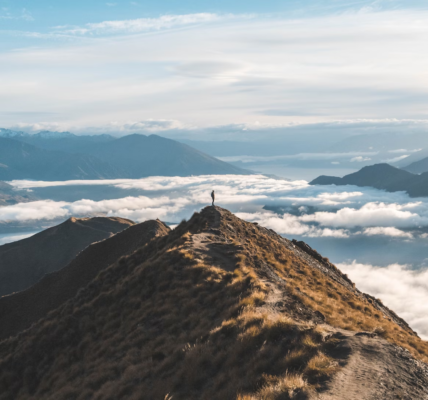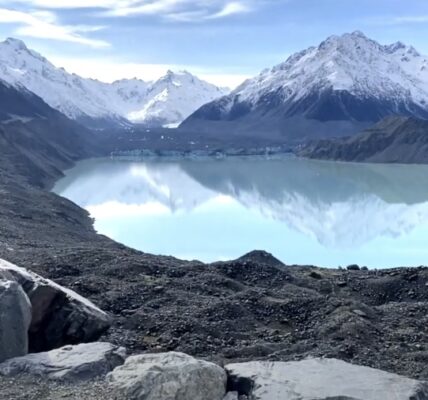Roys Peak in New Zealand offers one of the most stunning panoramas in the Southern Lakes region, drawing hikers and photography enthusiasts from around the world. Situated near Wanaka, this peak stands as a testament to New Zealand’s rich natural beauty and challenging landscapes. In this detailed guide, we explore the allure of Roys Peak, the essentials of the famous Roys Peak walk, and everything you need to prepare for this adventure.
Introduction to Roys Peak
Roys Peak is an iconic summit located in the heart of the South Island of New Zealand. Standing at a height of 1,578 meters (5,177 feet), this mountain offers breathtaking views of Lake Wanaka and the surrounding peaks of the Southern Alps. The area is not just a hiker’s paradise but also a significant point of interest in New Zealand’s tourism, often featured in travel documentaries and magazines.
Location
Roys Peak is situated near Wanaka, a picturesque town on the South Island of New Zealand. It lies within close proximity to the town center, making it easily accessible for visitors. The trailhead for Roys Peak is located approximately 6 kilometers from Wanaka town center.
Height
The summit of Roys Peak reaches an impressive elevation of 1,578 meters above sea level, providing stunning panoramic views of the surrounding landscape. This elevation makes it one of the prominent peaks in the region, attracting adventurers and nature enthusiasts from around the world.
Popular Activities
Roys Peak offers a range of activities for visitors to enjoy, making it a versatile destination for outdoor enthusiasts. Some of the popular activities include:
- Hiking: The most common activity at Roys Peak is hiking. The well-maintained trail provides a challenging yet rewarding trek to the summit. Hikers are treated to spectacular vistas along the way, with ample opportunities to capture stunning photographs of the surrounding scenery;
- Photography: Roys Peak is renowned for its stunning panoramic views, making it a paradise for photographers. From sunrise to sunset, the changing light conditions create mesmerizing photo opportunities, showcasing the natural beauty of the South Island landscape;
- Wildlife Observation: The area surrounding Roys Peak is rich in biodiversity, providing ample opportunities for wildlife observation. Visitors may encounter native bird species such as kea parrots and fantails, as well as various species of alpine flora and fauna.
Historical Significance of Roys Peak
Roys Peak holds a rich historical significance, reflecting the early exploration and development of New Zealand. The mountain’s history is intertwined with the cultural heritage of the Māori people and the pioneering efforts of European settlers.
Māori Navigation and Connection to the Land
The Māori people, indigenous to New Zealand, have a profound connection to the land and its features. Roys Peak played a crucial role in Māori navigation, serving as a prominent landmark for wayfinding across the South Island’s rugged terrain.
- Roys Peak served as a navigational aid for Māori travelers, guiding them through the challenging landscape;
- Its prominence in the region made it an essential point of reference for Māori cultural and trade routes;
- The mountain’s significance in Māori culture highlights its enduring importance in New Zealand’s history.
European Settlement and Sheep Farming
With the arrival of European settlers in the 19th century, the landscape surrounding Roys Peak underwent significant transformation. The fertile valleys and grassy slopes attracted settlers to establish sheep farms in the area.
- European settlers utilized the fertile land around Roys Peak for sheep farming, contributing to the region’s agricultural development;
- Sheep grazing became a common sight on the slopes of Roys Peak, shaping the pastoral landscape of the area;
- The introduction of European farming practices marked a new chapter in the history of Roys Peak, intertwining its story with that of European colonization in New Zealand.
Tourism Development and Conservation Efforts
In the 20th century, New Zealand experienced a boom in tourism, driven by its stunning natural landscapes and outdoor recreational opportunities. Roys Peak emerged as a popular destination for hikers and nature enthusiasts, attracting visitors from around the world.
- The growing popularity of Roys Peak among tourists led to increased attention to conservation efforts in the area;
- New Zealand implemented measures to preserve the natural beauty of Roys Peak while managing the impact of tourism on the environment;
- Conservation initiatives aimed to maintain the ecological balance of Roys Peak and its surrounding ecosystems, ensuring its sustainability for future generations;
- Educational programs and interpretive signage were introduced to raise awareness about the importance of conservation and environmental stewardship.
Eco-Tourism and Sustainable Practices
Today, Roys Peak stands as a symbol of New Zealand’s commitment to sustainable tourism practices. The area manages to balance visitor enjoyment with environmental conservation, promoting eco-friendly initiatives to protect its natural landscapes.
- Eco-tourism has become increasingly prevalent at Roys Peak, with visitors encouraged to explore the area responsibly;
- Sustainable practices, such as waste reduction and trail maintenance, are implemented to minimize the environmental footprint of tourism activities;
- Roys Peak serves as a model for eco-tourism destinations worldwide, showcasing the benefits of preserving natural landscapes while promoting responsible travel practices;
- Collaborative efforts between government agencies, conservation organizations, and local communities ensure the long-term protection and sustainability of Roys Peak for future generations to enjoy.
Roys Peak Walk: An Overview

Renowned for its challenging yet rewarding nature, this track offers a direct ascent to the summit and back, showcasing panoramic views that are simply unparalleled. Below, we delve into the intricacies of this iconic hike, providing comprehensive details for an unforgettable adventure.
Walk Details
The Roys Peak track spans approximately 16 kilometers round trip, making it a substantial endeavor for hikers. This distance encompasses the journey from the base to the summit and back again, offering a comprehensive exploration of the surrounding terrain.
- Distance: Approximately 16 km return;
- Duration: The entire excursion typically requires between 5 to 7 hours to complete. However, this timeframe is subject to variation based on individual hiking pace, weather conditions, and the amount of time spent at the summit;
- Difficulty: Roys Peak is renowned for its challenging nature, requiring a moderate to high level of physical fitness and stamina. The ascent involves steep inclines and uneven terrain, presenting a formidable challenge for even the most experienced hikers.
Trail Features
As hikers embark on the Roys Peak track, they are greeted with a plethora of natural wonders and awe-inspiring vistas along the way. Here are some notable features of the trail:
- Scenic Beauty: Throughout the hike, adventurers are treated to stunning panoramic views of Lake Wanaka, the surrounding mountains, and the picturesque landscapes of the Southern Alps;
- Flora and Fauna: The trail meanders through diverse ecosystems, offering glimpses of New Zealand’s unique flora and fauna. Keep an eye out for native bird species and vibrant alpine vegetation dotting the landscape;
- Challenging Terrain: Roys Peak is characterized by rugged terrain and steep inclines, presenting a formidable challenge for hikers. Sturdy footwear and adequate preparation are essential for navigating the rocky paths and gravel tracks;
- Summit Experience: Upon reaching the summit, hikers are rewarded with a breathtaking panorama that stretches as far as the eye can see. The unparalleled views encompass vast stretches of wilderness, including the iconic peaks of Mount Aspiring National Park.
What to Expect on the Hike
Hiking Roys Peak is both challenging and rewarding. The path is well-maintained but steep, with an elevation gain of about 1,228 meters from the base to the summit. Hikers are treated to ever-changing views, with the most spectacular panorama waiting at the summit.
Scenes along the hike:
Terrain and Elevation
Roys Peak trail presents a well-maintained yet demanding path, characterized by its steep inclines and rugged terrain. Hikers can anticipate the following elevation gain and terrain features as they progress along the trail.
- Base to halfway point: At the outset of the hike, adventurers traverse through gently rolling hills and pastoral land, providing a serene introduction to the journey. The terrain here is relatively gentle, allowing hikers to acclimate to the trail while enjoying panoramic views of the surrounding countryside;
- Halfway to summit: As hikers progress beyond the halfway point, the terrain transitions into a more rugged landscape characterized by rocky outcrops and uneven footing. This section of the trail presents a more significant challenge, requiring careful navigation and stamina to overcome the steep inclines;
- Summit: The pinnacle of the Roys Peak hike offers an unparalleled reward in the form of 360-degree views that stretch as far as the eye can see. From this vantage point, hikers are treated to breathtaking vistas of Lake Wanaka, the towering peaks of Mount Aspiring, and the vast expanse of the Southern Alps, making the arduous ascent well worth the effort.
Elevation Gain
The elevation gain from the base to the summit of Roys Peak is approximately 1,228 meters, showcasing the considerable ascent that hikers must conquer to reach the pinnacle of this iconic hike. This substantial elevation gain presents a formidable challenge, requiring endurance and determination to ascend to the summit and reap the rewards of the breathtaking panoramic views that await.
Scenic Highlights
Throughout the hike, adventurers are treated to ever-changing vistas that showcase the natural beauty of the surrounding landscape. Here are the scenic highlights that await hikers at various points along the trail.
- Base to Halfway Point: As hikers begin their ascent, they traverse rolling hills and pastoral land, offering glimpses of New Zealand’s picturesque countryside. The gentle terrain in this section of the trail provides an opportunity for hikers to appreciate the tranquility of the surroundings while gradually building momentum for the more challenging sections ahead;
- Halfway to Summit: The terrain becomes increasingly rugged, with rocky outcrops dotting the landscape. Hikers must navigate through this challenging terrain as they approach the summit, carefully choosing their footing and maintaining focus amidst the steep inclines. Despite the demanding nature of this section, the ever-changing scenery serves as a constant source of inspiration, motivating hikers to press on towards their goal;
- Summit: Upon reaching the summit, hikers are rewarded with a breathtaking 360-degree panorama that encompasses Lake Wanaka, the majestic peaks of Mount Aspiring, and the sprawling expanse of the Southern Alps. This awe-inspiring view serves as the ultimate reward for the strenuous climb to the top, offering a moment of respite and reflection amidst the splendor of nature’s grandeur.
Best Time to Visit Roys Peak
The best time to undertake the Roys Peak walk is during the New Zealand spring (September to November) or autumn (March to May). These seasons provide the most favorable weather conditions—cool temperatures and clearer skies. Summer months are also popular but can be quite warm, while winter requires additional caution due to snow and ice.
| Season | Months | Weather Conditions | Trail Conditions | Popularity |
|---|---|---|---|---|
| Spring | September to November | Cool temperatures (8°C to 18°C), clearer skies | Slightly muddy trails due to melting snow, rejuvenated landscape with greenery | Moderate foot traffic, providing a balance between solitude and company |
| Summer | December to February | Warm temperatures (12°C to 25°C), occasional heatwaves | Dry and dusty trails, potential crowding at Roys Peak peak, especially on weekends and holidays | Peak tourist season, drawing a large number of visitors |
| Autumn | March to May | Mild temperatures (7°C to 17°C), clearer skies | Less congested trails compared to summer, vibrant autumn colors in landscape | Moderate foot traffic, appealing choice for hikers seeking tranquility |
| Winter | June to August | Cold temperatures (-3°C to 8°C), snowfall common | Snow and ice-covered trails, slippery conditions, requires appropriate gear | Low foot traffic due to adverse weather conditions, suitable for seasoned hikers |
Preparing for the Hike

Proper preparation is key to enjoying and completing the Roys Peak walk safely. Here’s what you should consider packing:
Essential Gear
Before setting out on the Roys Peak hike, be sure to pack the following essential gear:
- Sturdy Hiking Boots: Choose durable hiking boots with excellent traction and ankle support. The terrain on Roys Peak can be rugged, so sturdy footwear is essential to prevent slips and injuries;
- Weather-Appropriate Clothing: Dress in layers to adapt to changing weather conditions. Start with a moisture-wicking base layer to keep sweat away from your skin, add insulating layers for warmth, and top it off with a waterproof jacket to shield against rain and wind;
- Sunscreen and Hat: Protect your skin from sunburn by applying sunscreen with a high SPF rating before starting the hike. Wear a wide-brimmed hat to shade your face and neck from the sun’s harsh rays.
Food and Hydration
To stay fueled and hydrated throughout the hike, pack the following items:
- Plenty of Water: Carry an adequate supply of water in a reusable water bottle or hydration bladder. Aim to drink at least one liter of water per hour to prevent dehydration, especially on hot days;
- Nutritious Snacks: Pack lightweight snacks such as trail mix, energy bars, and fresh fruit to keep your energy levels up during the hike. Choose snacks that provide a balance of carbohydrates, protein, and healthy fats to sustain your endurance.
Additional Essentials
Don’t forget these essential items to enhance your hiking experience:
- Camera or Smartphone: Capture the breathtaking scenery and memorable moments along the Roys Peak trail by bringing a camera or smartphone with a high-quality camera. Ensure your device is fully charged or pack a portable power bank to recharge it during the hike;
- Navigation Tools: While the Roys Peak trail is well-marked, it’s always wise to carry a map, compass, or GPS device as a backup navigation tool. Familiarize yourself with the trail route and landmarks before starting the hike;
- First Aid Kit: Pack a compact first aid kit containing essentials such as adhesive bandages, antiseptic wipes, blister pads, and pain relievers. Be prepared to address minor injuries or ailments while on the trail.
Local Regulations and Safety Tips
Adhering to local regulations is crucial for the safety of all hikers and the preservation of the environment. Roys Peak is located on public conservation land, and the Department of Conservation in New Zealand manages the track.
Local Regulations
Roys Peak is subject to regulations set forth by the Department of Conservation to safeguard both hikers and the ecosystem. These regulations include:
| Regulation | Description |
|---|---|
| Track Management Plan | Roys Peak has a designated track managed by the Department of Conservation. Hikers must adhere to this designated route. |
| Conservation of Flora and Fauna | Hikers are required to respect and protect the native plant and animal species along the trail. |
| Waste Management | Carry out all waste, including food wrappers and tissues. Dispose of waste properly in designated bins or facilities. |
| Campfire Restrictions | Open fires are prohibited. Use of portable gas cookers is permitted in designated areas only. |
| No Hunting or Fishing | The area is protected, and hunting or fishing is strictly prohibited. |
Safety Tips
In addition to complying with regulations, hikers should follow safety tips to ensure a safe and enjoyable experience on Roys Peak:
- Check the Weather Forecast: Weather conditions in mountainous regions can change rapidly. Before embarking on the hike, check the local weather forecast to prepare accordingly. Websites or apps like MetService provide up-to-date weather information for the Wanaka area;
- Inform Someone of Your Hiking Plans: Before setting out, inform a trusted friend or family member of your intended hiking route and estimated return time. In the event of an emergency, this information can assist search and rescue efforts;
- Stay on Marked Trails: Veering off designated trails can lead to environmental damage and increase the risk of getting lost. Follow signage and markers to stay on the approved path;
- Be Mindful of Wildlife and Plant Life: Roys Peak is home to diverse flora and fauna. Respect the natural habitat by avoiding disturbance to wildlife and refraining from picking plants or flowers. Be aware of any wildlife encounters and maintain a safe distance.
Conclusion
This article has explored the essential aspects of Roys Peak in New Zealand, from its historical significance to detailed insights into the Roys Peak walk. For adventurers and nature lovers alike, Roys Peak offers an unforgettable experience that highlights the raw beauty of New Zealand’s landscapes. Whether you are seeking the thrill of a challenging hike or the peace of panoramic views, Roys Peak is a destination that should not be missed.
FAQ
No permits are required, but park regulations and guidelines must be followed.
The hike is considered challenging due to its steep and continuous ascent.
There are no facilities on the trail; hikers should plan accordingly.
Overnight camping is not allowed on Roys Peak to protect the area’s natural environment.







